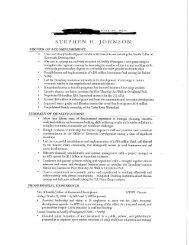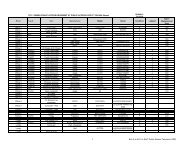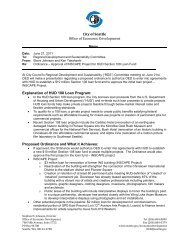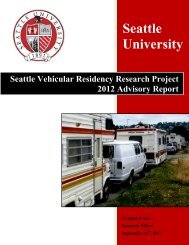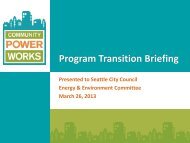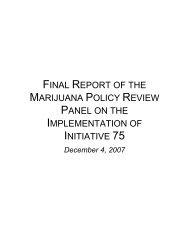2013 Water System Plan, Volume II - Seattle City Clerk's Office - City ...
2013 Water System Plan, Volume II - Seattle City Clerk's Office - City ...
2013 Water System Plan, Volume II - Seattle City Clerk's Office - City ...
You also want an ePaper? Increase the reach of your titles
YUMPU automatically turns print PDFs into web optimized ePapers that Google loves.
the extent to which price-induced conservation overlaps with passive and programmatic<br />
conservation. Each uncertainty was modeled by specifying a probability distribution around the<br />
mean value of each variable. Many sources were consulted to define the range of uncertainty 5<br />
and the shape of the distributions. The sources and assumptions used to characterize<br />
continuous uncertainties are outlined below.<br />
Forecasts of Households and Employment: Two different sources were consulted to<br />
establish uncertainty ranges around the forecasts of long term demographic growth. In<br />
2007, the Washington State <strong>Office</strong> of Financial Management (OFM) produced high and low<br />
forecasts of population by county based on historical variability in net migration rates. Dick<br />
Conway and Associates developed high and low alternatives around the 2002 PSRC long<br />
term regional forecasts of population and employment (but not households) based on<br />
optimistic and pessimistic scenarios for the local and national economies 6 . The greater<br />
geographical specificity of the OFM forecasts was combined with the more rigorous<br />
methodology and wider range between low and high provided by Dick Conway’s analysis.<br />
The OFM uncertainty ranges are calibrated to 2005 and the Conway uncertainty ranges are<br />
calibrated to 2000. Both were brought forward and calibrated to 2010 so that low, medium<br />
and high forecasts all start of from the same point in 2010. The ranges of uncertainty<br />
around the projections of households, employment and population used in the demand<br />
forecast model are shown in the table, below. The forecast number of multifamily<br />
households in 2060, for example, is 28% less than the baseline forecast in the low growth<br />
scenario and 47% higher in the high growth scenario.<br />
Uncertainty Ranges Around Mean Values<br />
Associated with High and Low Demographic Growth Scenarios<br />
2030 2060<br />
Low High Low High<br />
Single Family Households -6% 9% -10% 18%<br />
Multifamily Households -16% 26% -28% 47%<br />
Employment -7% 12% -14% 24%<br />
Population* -11% 17% -21% 35%<br />
* The number of single and multifamily households rather than population is used in the<br />
demand forecast model.<br />
The ranges around single and multi-family households were derived from the reported high<br />
and low population values and the assumption that variability around the single family<br />
forecast is less than for the forecast of multifamily households. Note that the potential<br />
variation from forecast values is expected to be greater on the high side than on the low<br />
side.<br />
Growth in the Price of <strong>Water</strong>: <strong>System</strong> water rates are obtained by dividing each year’s<br />
projected revenue requirement by projected demand. Uncertainty about future water prices<br />
derives from variability in both of these terms. The baseline assumption is that after<br />
significant increases in water and sewer rates already adopted or anticipated through 2014,<br />
growth in inflation-adjusted retail water rates will ramp down to 0.4% per year by 2020 and<br />
remain there through the forecast period. This is slower than the average historical rate of<br />
growth but is consistent with the 20-year rate model forecast used elsewhere in this <strong>Plan</strong>.<br />
The range of uncertainty around this is skewed very much on the high side, minus 50% to<br />
5 Each range is characterized by a high and low value representing two standard deviations from the mean.<br />
6 Scenarios developed by DRI-WEFA (now known as Global Insights, Inc.)<br />
FINAL Page 17 of 22 December 2011



